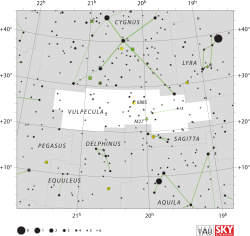Alpha Vulpeculae
| Observation data Epoch J2000.0 Equinox J2000.0 |
|
|---|---|
| Constellation | Vulpecula |
| Right ascension | 19h 28m 42.330s |
| Declination | +24° 39′ 53.65″ |
| Apparent magnitude (V) | 4.40 |
| Characteristics | |
| Spectral type | M1 III |
| B−V color index | 1.487 |
| Variable type | +1.81 |
| Astrometry | |
| Radial velocity (Rv) | −84.91 ± 0.26 km/s |
| Proper motion (μ) |
RA: –126.13 ± 0.19 mas/yr Dec.: –107.44 ± 0.22 mas/yr |
| Parallax (π) | 10.97 ± 0.28mas |
| Distance | 297 ± 8 ly (91 ± 2 pc) |
| Details | |
| Radius | 42 R☉ |
| Luminosity | 400 L☉ |
| Surface gravity (log g) | 1.5 cgs |
| Temperature | 3,990 K |
| Rotational velocity (v sin i) | 4.6 km/s |
| Other designations | |
| Database references | |
| SIMBAD | data |
Alpha Vulpeculae (Alpha Vul, α Vulpeculae, α Vul) is the brightest star in the constellation Vulpecula. It has a traditional name, variously represented as Lukida, Lucida Anseris, or Anser, a tradition kept from when the constellation had the name Vulpecula et Anser 'the fox and the goose'.
Alpha Vulpeculae is a red giant of spectral class M1 and has apparent magnitude +4.4. It is approximately 297 light years from Earth. It forms a wide optical binary with 8 Vulpeculae.
It has been analysed as a member of the Arcturus stream, a group of stars with high proper motion and metal-poor properties thought to be the remnants of a small galaxy consumed by the Milky Way.
...
Wikipedia

